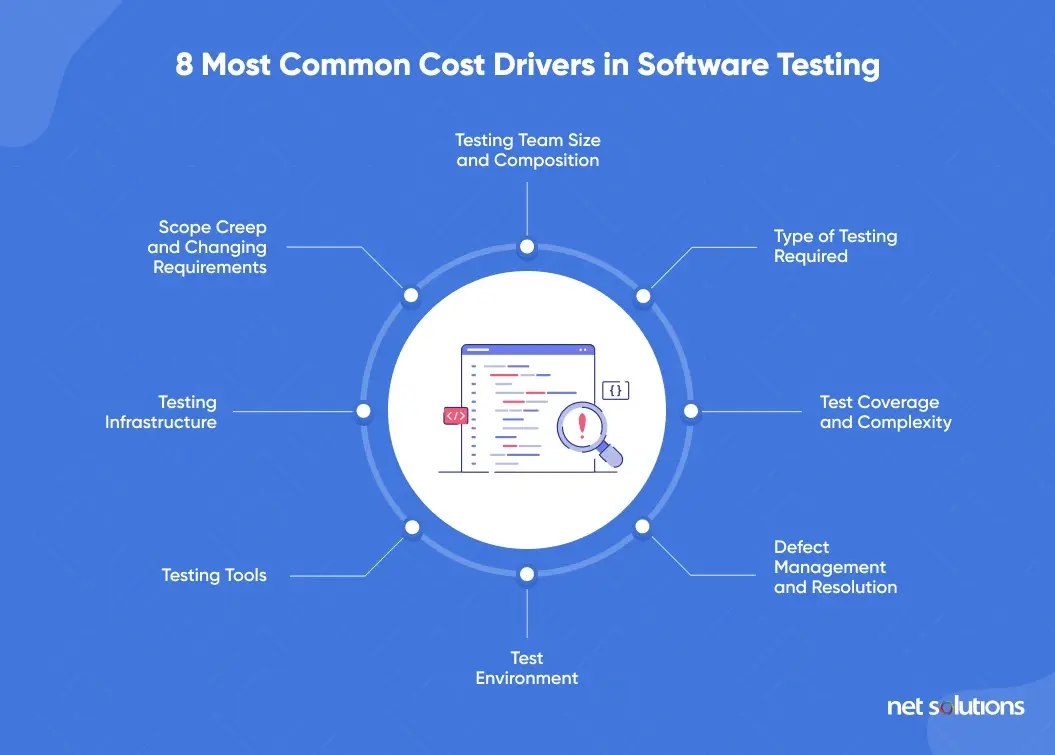Software testing is integral to the development process, even if it’s not the most glamorous part of the equation.
Quality Assurance (QA) helps ensure that each software release meets established requirements, dramatically reduces bugs, and results in a secure, high-quality product at each release.
This blog post covers the fundamental components of software testing. It also explores several ways to reduce the time, effort, and costs involved in thoroughly testing your software products—without sacrificing quality!
Most Common Cost Drivers in Software Testing
Reducing the time and labor associated with software testing begins with understanding all the factors that drive up costs in the first place.
Let’s survey the software testing landscape, exploring the seven most significant factors that impact cost. These factors include:
- The size of your testing team and the expertise required
- The type of testing your software demands
- Test coverage and complexity
- Defect management and resolution strategies
- The test environment you’ve designed
- The testing tools you use
- Your testing infrastructure
- Any scope creep and shifting requirements during the development process
We’ll explore each of these cost drivers in detail now.
1. Testing team
Product quality begins with the teams creating them. That’s as true for designing a luxury car as for building a quality software product.
Just as you should never skimp on design and development, you don’t want to cut corners on engaging skilled testing professionals.
There are ways to reduce costs and still work with talented testers (more about that below), but refusing to fill key roles on the testing team is not one for them. It will cost you more in the long run due to rework, unsatisfied clients, and other issues.
The roles you’ll require will vary depending on the software you produce, but here are some key positions within software testing teams.
- Quality Assurance Leads will guide the testing team, set strategy, and serve as a point of contact between different departments.
- Quality Assurance Engineers bring complete technical knowledge to the process and orchestrate testing procedures and processes.
- Testing Engineers design the testing process for specific software components, using their expertise to optimize resources and efforts. This category includes usability testing, manual testing, and automated testing. Companies often assign individual engineers to test each category.
- Network Testing Engineers specialize in network and database testing, developing load- and stress tests to see what an application can handle.
- Test Library and Configuration Specialists manage test-script change, maintain test-script version control, manage test-script reuse libraries, and create test builds.
- Software Testers handle the testing, drawing from their software engineering background to perform tests, analyze the results, create test designs, and verify that testing meets all the necessary standards.
- Security Testers ensure your software meets the highest cybersecurity standards, protecting your data from bad actors.
- Automation Testers use automated tools for an expedited testing process, which is extremely helpful with large, complex projects that undergo frequent changes.
- Performance Testers ensure a system performs well and maintains stability under high workloads.
The costs of hiring an in-house team will vary from one region to the next. However, hiring an outsourcing team to handle QA is almost always more cost-effective since salaried employees come with additional costs.
You can also leverage lower labor costs by working with outsourcing companies overseas. However, if you hire in-house staff, here is a rough salary estimate for common QA positions within the United States.
IMPORTANT: These figures are estimated average base salaries in the United States (Source: Salary.com and Payscale.com), and they do not factor in the high costs of living associated with major tech hubs like San Francisco and New York. They also don’t include additional costs like benefits, onboarding, payroll taxes, etc.
Looking to save money on QA testing without sacrificing quality? Consider outsourcing your Quality Assurance overseas. Review our ultimate outsourcing guide to learn more.
2. Type of testing required
Software testing is a vast field that includes many different types of tests. Your testing needs will vary based on your software’s functionality and requirements.
We’ve compiled a comprehensive list of 25 different types of software testing that QA teams perform, with a detailed explanation of each. Check it out if you want to dive deep into the many tests our QA teams perform.
We can’t cover every conceivable test in this blog post, but here is a short list of common QA tests:
- Functional testing includes a range of tests that evaluate performance related directly to a product’s functionality. In other words, does the software do what users expect it to do?
Functionality testing includes unit testing, integration testing, regression testing, acceptance testing, performance testing, and much more. - Non-functional testing involves testing elements like User Experience (UX), security, performance, and other items that are outside what users expect to accomplish with the software.
- Other types of testing include API testing, compatibility testing, multi-latency testing, and more.
The testing activities you engage in will directly relate to your overall testing strategy, which is tied to your project requirements and overarching vision.
3. Test coverage and complexity
The software testing process will vary considerably from project to project, with more complicated software requiring greater testing time and expertise.
For example, an app such as the Uber passenger app has many moving parts. It needs to integrate with GPS and other APIs and its own separate Uber driver app that connects riders with drivers. It also needs to calculate rates in different areas based on supply and demand and interface with payment system APIs worldwide.
As you can imagine, every Uber release requires extensive testing before taking it live because a glitch could cost the company millions of dollars in short order.
By comparison, a simple minimum viable product (MVP) for a startup selling a productivity app will have fewer variables to consider and possibly no APIs to interface with.
The risks of releasing an imperfect version are minimal with an initial MVP release, given its (likely) small client base. In other words, while MVP testing remains vital, it’s usually not nearly as extensive as with an app like Uber.
These two scenarios represent radically different test coverage requirements; testing costs will reflect those differences.
4. Defect management and resolution
Software testing aims to identify, report, track, and resolve software defects before introducing a product or a new release.
Everything comes with a price, and resolving the issues that testing teams spot (i.e., debugging) should be factored into your total cost of Quality Assurance. While some bugs inevitably slip through, prioritizing the most important bug fixes will make your product viable when it hits the market.
Strategic defect management and resolution impact software quality, reduce rework and save money in the long run.
5. Test environment
Creating the proper testing environment for your QA team allows them to do their job efficiently and effectively, saving you money in the long run.
An efficient test environment includes:
- High-quality hardware
- Solid infrastructure and support
- State-of-the-art testing tools and software (see next section for examples)
Investing in the proper testing environment for an in-house team is an up-front cost that will save you money. Of course, you can always outsource your testing to a qualified partner who has already invested in the proper infrastructure and employs all the best practices. This saves on both short-term and long-term expenses.
6. Testing tools
Cutting-edge software testing tools are a worthwhile upfront investment since they allow testing teams to work more efficiently and effectively. If hiring an outsourcing partner to handle your QA testing, ensure they use the latest tools.
Popular, effective QA testing and automation tools include:
7. Testing infrastructure
Testing infrastructure refers to the environment a company sets up to perform its QA work efficiently and effectively.
This includes physical systems and processes, and effective QA teams leverage virtualization and cloud-based technology to reduce costs and improve efficiency and scalability.
If you outsource your QA testing, ask prospective outsourcing partners challenging questions about their testing infrastructure and how it relates to their overall strategy.
8. Scope creep and changing requirements
Scope creep occurs when a software project expands beyond the initial goals and requirements without team members realizing it’s happening. Add a feature here, tweak a feature there, and suddenly, you have a release that goes far beyond the original requirements.
Scope creep drives the price of design, development, and QA testing. Combatting scope creep requires foresight and strategy.
Methodologies like Agile Scrum, which emphasize regular communication and smart documentation procedures, help reduce scope creep and manage QA costs.
How to Reduce the Cost of Software Testing?
Let’s be clear about this from the start. You should never compromise quality to save money on software testing. And luckily, that’s not required!
Adopting the right QA strategy will save you money in the long run. Just as regular car maintenance protects your overall budget, a cutting-edge strategy for software testing is a smart investment.
Here are five ways to reduce the cost of software testing without compromising on quality and results.
1. Embrace continuous integration and continuous testing
Continuous QA testing and integration means regular testing throughout the development life cycle. This allows for early detection and shorter feedback loops between testers and developers—that way, issues don’t compound, and complex programming isn’t added to faulty code.
Testing automation is key to early error detection, so investing in the right software tools to support your QA infrastructure is essential. Work continuous integration into your test plan, and create a culture that values strategic testing and clean code.
Kitco, a precious metals trading platform, took this approach when building their Android app, hiring Net Solutions to perform testing each night.
Since Net Solutions is on the opposite side of the world from Kitco, our QA engineers worked during the daytime here in India, and their developers received a full report in their inboxes before sitting down to work each morning.
2. Adopt Test-Driven Development (TDD)
Test-Driven Development (TDD) is an approach to software testing that involves writing unit tests before writing a single line of code. This helps identify functionalities not working properly early in the coding process.
For example, when employing TDD, you might write a function with three conditional statements attached. In that case, you would write three separate test cases for each condition and determine quickly what works and what doesn’t.
TDD helps developers:
- Achieve cleaner code refactoring
- Produce stronger documentation related to their code
- Endure less rework required for debugging
TDD also boosts code readability and produces better architecture, reducing costs and improving efficiency.
3. Implement risk-based testing
In software development terms, risk describes anything that could impact a software project’s success. Risks can increase timelines and inflate the budget.
Project managers typically identify potential risks before development begins, and Agile teams monitor risks and identify new ones as they proceed.
Risk-based testing homes in on those possible points of failure and focuses testing efforts around key risk mitigation. A risk-based testing approach helps identify major problems early when they’re still manageable.
4. Prioritize automated testing over manual testing
Techies are always developing ways to simplify people’s lives and automate tasks; software testing is no exception.
According to Venture Beat, 97% of software companies now use some degree of automated testing to expedite specific repetitive, time-consuming tasks associated with Quality Assurance.
Automated software testing tools can help QA teams:
- Work more efficiently
- Reduce labor costs
- Free up time and expertise to perform tasks that require human ingenuity
- Support repeatable testing processes
Automation requires some upfront costs if you use an in-house team, but the long-term payoff is indisputable.
5. Outsource your software testing
Quality Assurance is an ideal task to outsource to an experienced third party, especially when working with a partner on the opposite side of the world who can find bugs while your in-house engineering team sleeps.
Outsourcing benefits include:
- Cost reduction
- Greater efficiency
- Quicker time-to-market
- Freeing up in-house tech talent to focus on their core competencies
If you’re considering hiring an outsourcing partner to handle your QA testing, look at our guide to hiring a software development outsourcing firm.
Is Software Testing Really Necessary?
Yes, yes, and YES! Absolutely. Unequivocally.
QA is not only essential for producing quality software products that users adopt; it saves money in the long run by reducing rework and preventing teams from building on faulty code.
Of course, many teams don’t have the resources or the time to invest in building a full-scale QA department, and fortunately, they don’t have to. Plenty of outsourcing providers offer software testing services, and they can do it for much less than it costs to build an in-house QA team.
Need Help with Software Testing?
Net Solutions has been building high-quality software for more than three decades, producing apps for retail giants like Euro Car Parts and respected institutions like the Harvard Business Review.
We’re an experienced full-service development team using Agile and DevOps to ensure quality. Contact us to augment your development efforts.














